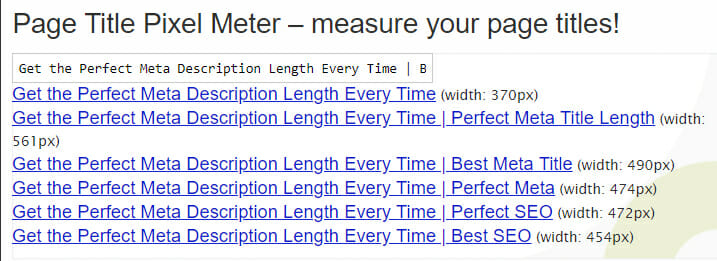You may have heard different numbers thrown around for meta description length — 145 characters, 155, 300… and the number gets even more skewed for meta titles. The truth is that Google doesn’t measure meta titles and descriptions in characters. It measures in pixels.
What will and won’t fit in your Google results is more precise than you may realize. The right programs will let you preview your Google results down to a T. (Of course, meta titles and descriptions are just suggestions. Google may choose to display something completely different.)
TLDR: Ignore the character count and start typing your meta data into an emulator.
Emulators to Get the Perfect Meta Description (and Title) Length
To get the perfect meta title length use a pixel-based meta title length simulator like Web Shop Optimizer. The process is trial and error: type a title then press enter to preview the length. The advantage of this system is you can easily look back on previous meta title ideas before making your final selection. The disadvantage is there is no real-time pixel count.

For your perfect meta title length, use a meta description length simulator like Spotibo. The display color-codes the cut-offs for each format. Use this to your advantage by fitting your call-to-action neatly within the parameters of each colored section. The main disadvantage of Spotibo is that while it lists the pixel counts for Bing and Yahoo (980), the emulator does not display words past the Google cutoff (920).

By typing your meta titles and descriptions into an emulator before posting, you can preview what the customer sees. You have more control over how your end product will look… assuming Google implements the meta tags you provide. (At the end of the day, Google decides whether to display your meta titles in search or create its own.)
SEO Considerations when Crafting Meta Descriptions:
When it comes to SEO, Google couldn’t care less what your pixel count is. That means your priority is to properly front-load and indicate your target keyword. The first word or phrase in your title should be a hard-hitter: the keyword you would sacrifice all the ice cream in the world to make your page rank #1 for. Don’t forget to follow that keyword with a | (called a pipe) to tell Google your keyword is finished. Everything after that first keyword matters significantly less. It’s advantageous to use the remaining space to supplement with related and complementary keywords, but it should never take precedence over your opener.
The perfect meta description length is the best way to take advantage of the space Google provides. Toss out your notes on “145 no 160 no 300 no 155 characters” and start using an emulator.
*Updated March 2022
